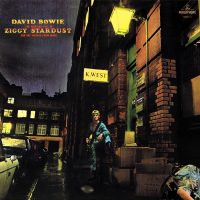 Written by: David Bowie
Written by: David Bowie
Recorded: 12 November 1971
Producers: Ken Scott, David Bowie
Released: 16 June 1972
Available on:
The Rise And Fall Of Ziggy Stardust And The Spiders From Mars
Bowie At The Beeb
ChangesNowBowie
Personnel
David Bowie: vocals, acoustic guitarMick Ronson: piano, vocals
Trevor Bolder: bass guitar
Woody Woodmansey: drums
Written about T. Rex singer Marc Bolan, ‘Lady Stardust’ opened side two of David Bowie’s fifth album The Rise And Fall Of Ziggy Stardust And The Spiders From Mars.
Bowie was increasingly playing with gender roles in the early Seventies, from the dress on the cover of The Man Who Sold The World to his January 1972 claim to Melody Maker that “I’m gay, and always have been, even when I was David Jones.”
‘Lady Stardust’ was perhaps his most explicit statement yet of his gender fluidity. From the outset his protagonist was given a female name, but the pronoun ‘he’ throughout. Lady Stardust is initially a figure of mockery and intrigue – he is laughed at for his long hair and “animal grace”, stared at for wearing make-up – but once he starts singing men and women alike are drawn to Lady Stardust.
Bowie’s narrator sings of smiling sadly “for a love I could not obey”, a clear echo of “the Love that dare not speak its name”, the famous closing line from Lord Alfred Douglas’s poem ‘Two Loves’, as quoted during Oscar Wilde’s indecency trial in 1895.
Same-sex acts conducted in private between consenting men over the age of 21 had been legalised in 1967 in England and Wales, with Scotland and Northern Ireland following in 1980 and 1981 respectively. Equality in the age of consent, however, did not arrive until 2001 (2009 in NI).
The very first Pride march took place in 1972, the year Bowie released The Rise And Fall Of Ziggy Stardust And The Spiders From Mars. Gay rights were a growing public concern, although it took some decades before state discrimination ended and gay people could marry, and schools and councils were able to fund educational projects to inform and support children.
Bowie wrote ‘Lady Stardust’ for Marc Bolan, his friend and sometime rival whose star was in the ascendent. In September 1971, two months before the recording of the song, T. Rex released the chart-topping album Electric Warrior, with its hit singles ‘Get It On’ and ‘Jeepster’.
Although Bowie was poised to leap into stardom with Ziggy Stardust, his successes thus far had been sporadic, with the 1969 hit ‘Space Oddity’ followed by a series of flops. Although he remained on good terms with Bolan, the imbalance in the two men’s fortunes must have caused mixed feelings.
An early master tape of the Ziggy Stardust album was compiled on 15 December 1971, although the album was still missing the songs ‘Starman’, ‘Rock ‘N’ Roll Suicide’, and ‘Suffragette City’.
At that stage the album was to be titled Round And Round. The running order had ‘Five Years’, ‘Soul Love’, ‘Moonage Daydream’, ‘Round And Round’, and ‘Amsterdam’ on side one; and ‘Hang On To Yourself’, ‘Ziggy Stardust’, ‘Velvet Goldmine’, ‘Holy Holy’, ‘Star’, and ‘Lady Stardust’ on the second half.
Bowie rarely performed ‘Lady Stardust’ live. It was, however, the opening song during his August 1972 shows at London’s Rainbow Theatre, during which Bolan’s likeness was projected onto the stage backdrop.
The Japanese single-CD edition of the Bowie compilation Nothing Has Changed included ‘Lady Stardust’ in place of ‘Golden Years’.

